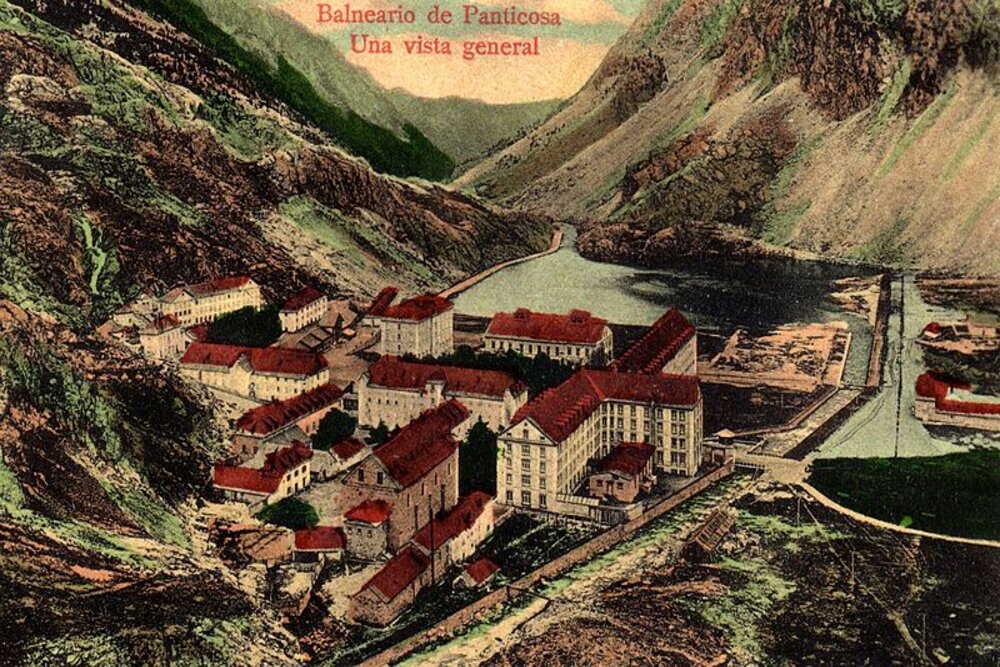Welcome to a history that goes back to the Roman period and that has reached our days transforming itself over time, but maintaining the essence of the centuries that have passed through it, that is the history of the Panticosa spa. Many of us associate this Aragonese valley with famous ski resorts such as Formigal which receives millions of snow lovers every season. Although at Uller we are passionate about action, we know that we all like our hours of relaxation. Therefore, whatever the season of the year, the Panticosa spa will open its doors for us to enjoy its “Roman baths”.

IT ALL STARTED WITH THE ROMAN BATHS
As many of you know in Ancient Rome it was customary to take long baths while debating and having endless conversations. It was precisely this tradition that brought the rich Romans closer to the towns of Osca (Huesca) and Cesaraugusta (Zaragoza). Many of us travel the roads of the Pyrenees every year to reach the Panticosa Valley, well, this journey was already done by the populations of Ancient Rome through the roads that linked ancient Hispania with Gaul following the course of the Gallego River. .
DISAPEARANCE IN MEDIEVAL TIMES
After the fall of the Roman Empire, the Panticosa Spa made a parenthesis in history since there are no medieval records on what happened to this area, then occupied by barbarians. Everything indicates that its difficult access and the frequent avalanches would bury the springs for several centuries.

THE REBIRTH OF THE PANTICOSA SPA
The century of enlightenment, reason and the rebirth of the classics has arrived. The Renaissance and the Enlightenment are going to give a boost to the interest in mineral-medicinal waters which was already developing throughout Europe. In this way, the juries of the Quiñón de Panticosa had a lot to do with it, since, being the owners of the baths, they signed a contract with some masons from Lanuza. In one year the first house in Baños was built, with which they realized the importance of the spa activity in Panticosa. At the end of the last decade of the 18th century, the spa reached a certain peak and caused great concern among some authorities for its conservation and future. During a time all the residents of the town could go to the spa for free.
Later, a second spring was discovered, that of Herpes, so a second bathhouse was built. The complications of the War of Independence in 1808 against the French meant that the spa ended up in the hands of businessmen from this country. Finally, King Ferdinand VII forced Quiñón to cede the exploitation of the waters to a wealthy landowner named Nicolás Guallart. Guallart built eight buildings that today constitute the nucleus of the spa.
THE SPLENDOR OF THE 19TH CENTURY
Throughout the 19th century, the Panticosa spa was modified and ended up becoming a great prestigious villa that could gather 1500 people. The buildings were nothing more and nothing less than hotels, villas and various services that gave them great autonomy. Its architecture had great French influence and its luxurious aesthetics made it an attraction for the most illustrious of the moment and the representatives of the Aragonese, Catalan, Basque and Madrid bourgeoisie. Characters who have made history in Spain and the world such as Niceto Alcalá Zamora, Santiago Ramón y Cajal, Ortega y Gasset or Primo de Rivera.

As you can see, the Panticosa spa has been adapting to the new times and today combines modernity with the past in a luxurious architecture that will offer you a number of services for your greatest comfort.
SERVICES AND FACILITIES OF THE PANTICOSA SPA
The Panticosa Spa offers three spaces where you can enjoy a day of relaxation and hot springs: the so-called Tiberio hot springs, the Quiñón Spa and the Gran Hotel thermal space.
BATHS OF TIBERIUS
This building has been designed by Belén Moneo and Jeff Brock whose design integrates into nature as if it were part of it. A space where light and water merge creating a relaxing atmosphere.
They offer a whole thermal circuit where you will find a central pool with a variety of jets of different heights, but also saunas, hot stones... And don't miss the solarium with views of the mountains!

On the other hand, there are oligometallic waters with four different types of sources in which their temperatures vary so that you can choose the one that best suits you at the moment. These are the spring of San Agustín, the source of Beauty or the Stomach, the spring of La Laguna and the Spring of Tiberio.
QUIÑÓN SPA
Its relatively new facilities will mean that you cannot avoid trying a room with a shower-massage, a chiropractic and chiropractic treatment room, an area for atmiatric (respiratory) treatments, and a thermal pool. Finally, it has a walking corridor for foot stimulation and strengthening of the ankle joints.

GRAN HOTEL THERMAL SPACE
The Gran Hotel Thermal Space is decorated in marble in dark colors that give it a unique and welcoming character. Its exclusive facilities include thermal pools, a vaporarium (hot steam treatment), a Swedish bucket (cold water bucket) and a rest area with hammocks for when you finish the thermal circuit.
Although water is the protagonist of the spa, you can also make use of dry cabins for massages and beauty treatments. In this area, its two bathtubs are famous: the Caracalla bathtub and the Melody bathtub.

Have you still not wanted to visit this spa? Take advantage of the freedom that nature offers you with these human constructions that are perfect for escaping for a weekend and disconnecting from the week. The Panticosa Spa is a success for those who have already tried it and its centuries of history make it one of the most prestigious spas in Spain.
QUESTIONS AND ANSWERS
- WHO RUNS THE PANTICOSA SPA?
The Panticosa Spa belongs to the Nozar group that has signed an agreement with the Vincci Hotels chain with which they manage everything related to leisure and luxury tourism as well as the hotel establishment located on the Las Margas golf course in Sabinanigo.
- WHERE IS PANTICOSA?
Panticosa is a Spanish municipality that belongs to the region of Alto Gállego, north of the province of Huesca within Aragon. Its extension is 95.9 square kilometers with a population of 800 inhabitants according to the INE of 2020.
- IS IT RECOMMENDED TO GO TO PANTICOSA IN SUMMER?
Yes, in summer Panticosa offers a lot of activities, one of them going to the spa we have talked about, but also rafting, baroque, canoeing, paragliding and many others.
- HOW OLD IS THE PANTICOSA SPA?
It is considered that the Panticosa spa has existed as such since 1899, since it is the year in which the Aguas de Panticosa society was inaugurated, although as we have seen its use dates back to Roman times.
- WHAT DOES THE PANTICOSA SPA OFFER FOR THE WINTER?
The Panticosa Spa for winter offers different offers such as a relaxing getaway, one that includes skiing in Formigal with ski pass included, as well as incredible experiences such as cross-country skiing, snowshoeing or sledding.
- WHAT VILLAGES TO VISIT NEAR PANTICOSA?
The towns you should visit near Panticosa are Lanuza, Sallent de Gállego and Hoz de Jaca. These three visits are almost mandatory if you are in the Tena Valley as they will leave you in love with its rural charm.
- HOW MANY PEOPLE VISIT THE SPA IN SUMMER?
The record number of guests collected in summer at the Panticosa spa is 30.000 and the main autonomous communities to visit it are Aragon, Catalonia, Levante and Madrid.
- HOW DOES THE THERMAL CIRCUIT WORK?
The thermal circuit lasts 75 minutes and is made up of several pools and dry areas. In addition, children from 3 years old can access all the facilities at the times established as family members.
- WHAT RESTAURANTS DOES THE PANTICOSA SPA OFFER?
The restaurants offered by the Panticosa Spa are El Lago Restaurant located in the Gran Hotel that contains a tasting menu consisting of appetizers, meat, fish and dessert. La Cafeteria Gran Hotel to enjoy a good morning coffee and first class wines and drinks. On the other hand, the Continental Restaurant which is a very varied buffet open 24 hours from Monday to Sunday. In addition, the Continental hotel also offers La Brasserie Restaurant with the best meats in the Pyrenees.
- CAN I PARK AT THE PANTICOSA SPA?
Yes, you can park in the parking lot of the Hotel Continental Balneario de Panticosa. If you are not a hotel guest, you can also use the motorhome parking or the covered area of the Panticosa motorhome area





















































































































